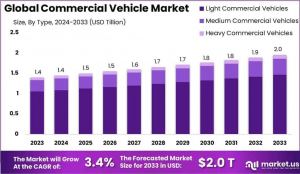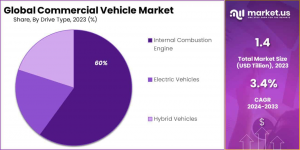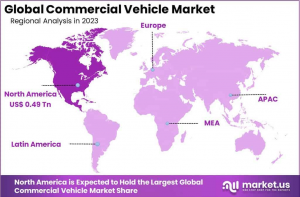The Global Commercial Vehicle Market size is expected to be worth around USD 2.0 trillion by 2033, from USD 1.4 trillion in 2023, growing at a CAGR of 3.4%.
North America holds 35.3% share of the Commercial Vehicle Market, valued at USD 0.49 trillion, due to a strong logistics industry and emission regulations.”
NEW YORK, NY, UNITED STATES, January 22, 2025 /EINPresswire.com/ -- Market Overview— Tajammul Pangarkar
The Global Commercial Vehicle Market size is expected to be worth around USD 2.0 trillion by 2033, from USD 1.4 trillion in 2023, growing at a CAGR of 3.4% during the forecast period from 2024 to 2033. North America dominated a 35.3% market share in 2023 and held USD 0.49 Trillion in revenue from the Commercial Vehicle Market.
The Commercial Vehicle (CV) market refers to the production, sale, and utilization of motor vehicles designed primarily for transporting goods, passengers, or specific business-related activities. These vehicles include trucks, vans, buses, and other heavy-duty vehicles used across sectors like logistics, construction, transportation, and public services.
The global CV market is driven by increasing demand for goods transportation, urbanization, and growing industrial activity. Technological innovations, such as electric and autonomous vehicles, are also shaping the future of the market, with players investing in sustainable and efficient solutions to meet the needs of an evolving economy.
The commercial vehicle market is on an upward trajectory, driven by the expanding global economy and increased demand for transportation and logistics solutions. Technological advancements in electric vehicles (EVs), autonomous driving, and telematics are paving the way for future growth. Governments across key markets are supporting this growth through incentives, regulations, and infrastructure development.
Policies aimed at reducing carbon emissions and improving fuel efficiency are stimulating the shift towards cleaner technologies. Furthermore, significant investments in electrification and smart mobility solutions offer considerable opportunities for market players. With rising demand for last-mile delivery services and urban logistics, there is a growing need for small and medium-sized commercial vehicles, which is further fueling the market's growth.
For both new entrants and established players in the commercial vehicle sector, strategic decisions will revolve around innovation, sustainability, and market adaptation. Companies must leverage this report's insights to align their strategies with consumer demand for green and efficient technologies. New players can find opportunities by entering underserved niches or focusing on emerging regions.
Existing players, on the other hand, can explore diversification into electric vehicles or connected transportation solutions to enhance their market position. Additionally, partnerships with tech firms for autonomous driving systems and telematics, as well as investing in after-sales services and fleet management, can further strengthen their competitive edge.
Curious About Market Trends? Request Your Complimentary Sample Report Today: https://market.us/report/commercial-vehicle-market/free-sample/
Key Takeaway
-The Global Commercial Vehicle Market size is expected to be worth around USD 2.0 trillion by 2033, from USD 1.4 trillion in 2023, growing at a CAGR of 3.4% during the forecast period from 2024 to 2033.
-In 2023, Light Commercial Vehicles held a dominant market position in the By Type segment of the Commercial Vehicle Market, with a 75% share.
-In 2023, Internal Combustion Engine held a dominant market position in the By Drive Type segment of the Commercial Vehicle Market, with a 60% share.
-In 2023, Logistics held a dominant market position in the end-use segment of the Commercial Vehicle Market, with a 26% share.
-North America dominated a 35.3% market share in 2023 and held USD 0.49 Trillion in revenue from the Commercial Vehicle Market.
Use Cases
1.Fleet Management for Delivery Companies: Commercial vehicles, such as trucks and vans, are essential for delivery companies that handle large volumes of goods. Fleet managers use advanced tracking and telematics systems to monitor the location, speed, and health of each vehicle. This helps optimize routes, reduce fuel consumption, and prevent breakdowns, improving the overall efficiency and reliability of the delivery service.
2. E-commerce Logistics and Last-Mile Delivery: As e-commerce grows, the demand for efficient last-mile delivery increases. Commercial vehicles are used to transport packages from distribution centers to customers. Companies are turning to electric commercial vehicles (EVs) and smaller, agile delivery vans to navigate urban areas, reduce emissions, and ensure timely deliveries, especially in high-density regions.
3. Public Transportation and Shuttle Services: Buses, minibuses, and other commercial vehicles are a crucial part of public transportation systems. They provide regular transportation options for commuters, students, and tourists. Cities and municipalities use these vehicles to ensure affordable, reliable, and eco-friendly transport solutions for urban and rural areas.
4. Construction and Heavy Equipment Transport: Commercial vehicles like dump trucks, flatbeds, and cement mixers are vital for construction projects. These vehicles transport heavy materials, machinery, and equipment to and from construction sites. By providing a strong backbone for the construction industry, they help maintain project timelines and reduce costs associated with material delays.
5. Mobile Healthcare Units: Commercial vehicles are increasingly used as mobile healthcare clinics. Equipped with medical facilities, these vehicles bring essential healthcare services to remote or underserved areas. From vaccination drives to diagnostic services, these vehicles enable healthcare providers to reach people who may not have access to traditional clinics.
Driving Factors
Urbanization and Infrastructure Development: The rapid growth of cities and expansion of infrastructure globally are fueling the demand for commercial vehicles. As urban areas grow, there is a need for logistics and transportation solutions, driving the demand for trucks, delivery vehicles, and buses.
E-Commerce Growth: The boom in e-commerce has led to an increase in demand for commercial delivery vehicles. Companies need trucks and vans to transport goods quickly and efficiently, driving growth in the light-duty vehicle segment.
Government Regulations and Environmental Standards: Stricter environmental regulations are pushing the adoption of cleaner, more fuel-efficient vehicles. Electric trucks, buses, and alternative fuel vehicles are becoming more popular as governments introduce regulations aimed at reducing emissions.
Advancements in Vehicle Technology: The development of more efficient engines, autonomous driving technologies, and smart fleet management systems is making commercial vehicles more cost-effective and easier to operate. These innovations are attracting businesses looking for efficiency gains.
Rising Demand for Public Transport Solutions: With an increasing focus on reducing traffic congestion and pollution, governments around the world are investing in public transportation infrastructure. This trend is driving demand for buses, coaches, and other commercial vehicles designed for public transport.
Report Segmentation
In 2023, light commercial vehicles dominated the commercial vehicle market by type, capturing 75% of the market share, driven by the growing need for efficient urban delivery solutions, particularly for last-mile e-commerce deliveries. Internal combustion engines (ICE) led the market by drive type with a 60% share, benefiting from established infrastructure and lower upfront costs, especially in regions with limited electric or hybrid options. In the end-use segment, logistics held the largest share at 26%, fueled by the global rise in e-commerce and the increasing demand for efficient and reliable supply chain transportation.
By Type
~Light Commercial Vehicles
~Medium Commercial Vehicles
~Heavy Commercial Vehicles
By Drive Type
~Internal Combustion Engine
~Electric Vehicles
~Hybrid Vehicles
By End-Use
~Industrial
~Mining & Construction
~Logistics
~Passenger Transportation
~Other End-Uses
Ready to Act on Market Opportunities? Buy Your Report Now and Get 30% off: https://market.us/purchase-report/?report_id=67446
Regional Analysis
The Commercial Vehicle Market shows notable differences across regions due to varying economic, environmental, and regulatory factors. In North America, the market holds the largest share at 35.3%, valued at USD 0.49 trillion. This leadership is supported by a strong logistics industry, advanced infrastructure, and strict emissions regulations that are encouraging the shift towards cleaner and more efficient vehicles.
Growth Opportunities
Electric and Hybrid Commercial Vehicles: With growing concerns about emissions and government regulations, there’s a significant opportunity in the electric and hybrid commercial vehicle segment. Investing in electric trucks, buses, and vans that cater to urban delivery needs can lead to long-term growth as governments push for greener transportation solutions.
Telematics and Fleet Management Technology: The integration of telematics and GPS tracking in commercial vehicles offers fleet operators better control and management. These technologies can optimize routes, reduce fuel consumption, and improve safety, driving demand for smart vehicles that help businesses run more efficiently.
Last-Mile Delivery Solutions: The rise of e-commerce has created an increased demand for efficient last-mile delivery solutions. Smaller commercial vehicles, like electric vans or autonomous delivery robots, can capitalize on this trend, offering faster, more sustainable delivery options for retailers and logistics companies.
Autonomous Commercial Vehicles: Autonomous vehicles are a growing trend in the commercial transport industry. Developing self-driving trucks and delivery vehicles can reduce labor costs and improve operational efficiency. Companies investing in this technology can lead the market in automation and innovation.
Expansion in Emerging Markets
As global trade expands and economies grow, emerging markets present an opportunity for commercial vehicle manufacturers. Providing affordable and durable commercial vehicles tailored to these regions, along with robust after-sales service, can help capture market share in developing economies.
Key Players
~Daimler AG
~Volvo Group
~Scania AB
~MAN SE
~Paccar Inc.
~Navistar International Corporation
~Ashok Leyland
~Tata Motors
~Isuzu Motors Ltd.
~Ford Motor Company
~General Motors
~Dongfeng Motor Corporation
~FAW Group Corporation
~Sinotruk
~IVECO S.p.A.
~Mitsubishi Fuso Truck and Bus Corporation
~Hino Motors, Ltd.
~Hyundai Motor Company
~Other Key Players
Not Sure? Request a Sample Report and See How Our Insights Can Drive Your Business: https://market.us/report/commercial-vehicle-market/free-sample/
Trending Factors
Increasing Demand for E-commerce Logistics: The growth of online shopping has led to a higher demand for commercial vehicles in logistics and delivery sectors. Delivery trucks, vans, and electric vehicles are increasingly being used to support the e-commerce boom.
Technological Advancements in Vehicle Fleet Management: Commercial vehicles are becoming more sophisticated with technology such as GPS tracking, telematics, and route optimization software. These innovations improve fleet management, reduce costs, and enhance operational efficiency for businesses.
Environmental Regulations and Electrification: Stricter environmental regulations and a push toward sustainability are driving the adoption of electric commercial vehicles (EVs). Governments worldwide are incentivizing businesses to switch to eco-friendly fleets to reduce emissions and comply with environmental standards.
Urbanization and Demand for Small Commercial Vehicles: As urban areas become more congested, there’s an increasing demand for smaller commercial vehicles, such as compact trucks and vans, which can navigate crowded city streets and offer more flexible logistics solutions.
Last-Mile Delivery and Micro-Fulfillment Centers: The rise of last-mile delivery services, where goods are delivered to customers’ doorsteps, is boosting demand for commercial vehicles designed for short-distance transportation. Additionally, the trend towards micro-fulfillment centers in urban areas is driving the need for more agile and efficient commercial vehicles.
Restraining Factors
High Initial Investment and Operational Costs: Commercial vehicles, especially trucks and buses, require a substantial upfront investment. Additionally, the high cost of maintenance, fuel, and insurance makes them expensive to operate, which can be a barrier for small and medium-sized businesses looking to expand their fleet.
Stringent Environmental Regulations: Governments are implementing stricter emissions standards, which is increasing the pressure on manufacturers to develop cleaner and more energy-efficient commercial vehicles. Compliance with these regulations can be costly, slowing down the pace of innovation and adding financial burdens on the industry.
Supply Chain Disruptions: The commercial vehicle market is highly dependent on the global supply chain for parts and raw materials. Events like natural disasters, geopolitical tensions, or trade disruptions can lead to delays in production and a shortage of key components, affecting vehicle availability and sales.
Conclusion
The Global Commercial Vehicle Market, projected to reach USD 2.0 trillion by 2033, is poised at the intersection of growth and technological innovation. Driven by increasing e-commerce, urbanization, and stringent environmental regulations, the market demands that both new and established players adopt advanced technologies like electric and autonomous vehicles to remain competitive. With North America leading in market share, the future success of companies hinges on their ability to navigate challenges such as high operational costs and supply chain disruptions while leveraging opportunities in electric vehicle technology and efficient fleet management. Strategic adaptation and technological integration are key for companies aiming to capitalize on the dynamic opportunities within this evolving market.
Lawrence John
Prudour
+91 91308 55334
Lawrence@prudour.com
Visit us on social media:
Facebook
LinkedIn
Legal Disclaimer:
EIN Presswire provides this news content "as is" without warranty of any kind. We do not accept any responsibility or liability for the accuracy, content, images, videos, licenses, completeness, legality, or reliability of the information contained in this article. If you have any complaints or copyright issues related to this article, kindly contact the author above.




